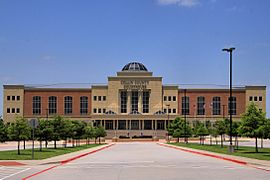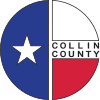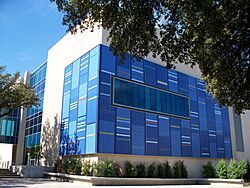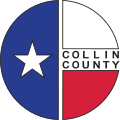Collin County, Texas facts for kids
Quick facts for kids
Collin County
|
|||
|---|---|---|---|

The Collin County Courthouse in McKinney
|
|||
|
|||

Location within the U.S. state of Texas
|
|||
 Texas's location within the U.S. |
|||
| Country | |||
| State | |||
| Founded | 1846 | ||
| Named for | Collin McKinney | ||
| Seat | McKinney | ||
| Largest city | Plano | ||
| Area | |||
| • Total | 886 sq mi (2,290 km2) | ||
| • Land | 841 sq mi (2,180 km2) | ||
| • Water | 45 sq mi (120 km2) 5.1% | ||
| Population
(2020)
|
|||
| • Total | 1,064,465 | ||
| • Estimate
(2021)
|
1,109,462 |
||
| • Density | 1,201.4/sq mi (463.87/km2) | ||
| Time zone | UTC−6 (Central) | ||
| • Summer (DST) | UTC−5 (CDT) | ||
| Congressional districts | 3rd, 4th, 32nd | ||
Collin County is a county in the U.S. state of Texas. It is part of the large Dallas-Fort Worth-Arlington metropolitan area. A small part of the big city of Dallas is also in Collin County.
In 2020, the county's population was over 1 million people. This makes it the sixth-most populated county in Texas. Its main city, where the county government is located, is McKinney.
Contents
History of Collin County
Long ago, different Native American tribes lived around Collin County. These included the Caddo, Comanche, Cherokee, Delaware, Kickapoo, and Tonkawa peoples.
The county and its main city, McKinney, are named after Collin McKinney. He was an important person in Texas history. Collin McKinney helped write the Texas Declaration of Independence. He was also the oldest person to sign it.
Geography of Collin County
Collin County covers about 886 square miles. Most of this area, about 841 square miles, is land. The rest, about 45 square miles, is covered by water.
Lakes in Collin County
- Lavon Lake is a major lake in the county.
Neighboring Counties
Collin County shares borders with several other counties:
- Grayson County (to the north)
- Fannin County (to the northeast)
- Hunt County (to the east)
- Rockwall County (to the southeast)
- Dallas County (to the south)
- Denton County (to the west)
Cities and Towns
Collin County is home to many cities and towns. Some of these are completely within the county. Others are shared with neighboring counties.
Main Cities in Collin County
- McKinney is the county seat, meaning it's where the county government is.
- Plano is the largest city in Collin County.
- Other important cities include Allen, Frisco, and Richardson.
Many other communities, from small towns to unincorporated areas, also make up Collin County.
People and Population
| Historical population | |||
|---|---|---|---|
| Census | Pop. | %± | |
| 1850 | 1,950 | — | |
| 1860 | 9,264 | 375.1% | |
| 1870 | 14,013 | 51.3% | |
| 1880 | 25,983 | 85.4% | |
| 1890 | 36,736 | 41.4% | |
| 1900 | 50,087 | 36.3% | |
| 1910 | 49,021 | −2.1% | |
| 1920 | 49,609 | 1.2% | |
| 1930 | 46,180 | −6.9% | |
| 1940 | 47,190 | 2.2% | |
| 1950 | 41,692 | −11.7% | |
| 1960 | 41,247 | −1.1% | |
| 1970 | 66,920 | 62.2% | |
| 1980 | 144,576 | 116.0% | |
| 1990 | 264,036 | 82.6% | |
| 2000 | 491,675 | 86.2% | |
| 2010 | 782,341 | 59.1% | |
| 2020 | 1,066,467 | 36.3% | |
| 2023 (est.) | 1,195,359 | 52.8% | |
| U.S. Decennial Census 1850–2010 2010–2019 |
|||
In 2000, about 491,675 people lived in Collin County. By 2020, the population had grown to over 1 million people. This shows how much the area has grown.
Collin County is a very diverse place. Many different cultures and backgrounds make up its population. In 2020, about half of the people were non-Hispanic White. About 10% were Black or African American, and 17.7% were Asian. Around 15.89% of the population was Hispanic or Latino.
Many people in Collin County speak a language other than English at home. This includes Spanish and various Asian languages.
Religions in Collin County
Most people in Collin County are Christian. However, because many people have moved to the county, other religions are also growing. These include Hinduism, Islam, and Judaism.
Education in Collin County
Collin County has many schools and colleges.
Schools for Kids (K-12)
Several independent school districts serve the students in Collin County. Some of the largest include:
- Allen Independent School District
- McKinney Independent School District
- Plano Independent School District
- Frisco Independent School District
- Wylie Independent School District
Colleges and Universities
Collin College is a community college with several campuses in the county. It opened its first campus in McKinney in 1985.
The University of Texas at Dallas (UT Dallas) also has a large part of its campus in Collin County. Other universities like Dallas Baptist University and the University of North Texas have extension sites here too.
Getting Around (Transportation)
Major highways cross Collin County, making it easy to travel by car. These include:
- U.S. Highway 75
- U.S. Highway 380
- Dallas North Tollway
- State Highway 190 (President George Bush Turnpike)
- State Highway 121 (Sam Rayburn Tollway)
Public transportation, like buses and trains, is limited in most of Collin County. However, there are discussions about expanding train lines in the future.
Parks and Outdoor Fun
Collin County has several parks and natural areas for outdoor activities. These include:
- Bratonia Park
- Myers Park
- Parkhill Prairie
- Sister Grove Park
- Trinity Trail
- Heard Natural Science Museum and Wildlife Sanctuary
News and Media
Collin County is part of the Dallas/Fort Worth media area. This means people can watch local TV news channels like KDFW-TV and WFAA-TV.
Local newspapers also cover news in the county. Some of these include the Allen American, Celina Record, and Plano Star-Courier.
Famous People from Collin County
Many interesting people have connections to Collin County:
- Collin McKinney (1766-1861) – A politician who helped write the Texas Declaration of Independence.
- Griff Barnett (1884-1958) – An actor born in Blue Ridge.
- Kyler Murray (Born 1997) – A football player for the Arizona Cardinals, from Allen.
- James W. Throckmorton (1825-1894) – The 12th Governor of Texas, who lived in McKinney.
Images for kids
See also
 In Spanish: Condado de Collin para niños
In Spanish: Condado de Collin para niños






